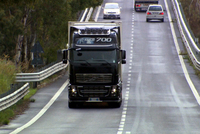Volvo Drivers from UK and Netherlands Participate in Major Safety Study - VIDEO STORY
STOCKHOLM - July 2, 2010: A large-scale safety research project is now being rolled out in collaboration with DHL Tradeteam in the UK and Dutch haulage firm Nijhof-Wassink. The aim is to study driver behaviour in various traffic situations and to examine how this behaviour interfaces with the truck’s on-board safety systems.
Click PLAY to watch video
EuroFOT (European Field Operational Test) is an EU project that brings together 28 European companies and organisations. The aim of the project is to gather information on how truck drivers behave in various traffic situations during their daily work, and to study how they are assisted by the truck’s on-board safety systems. This will be done both by filming the drivers and also by logging certain vehicle signals such as speed. A total of 30 Volvo trucks will be driven in regular daily operations by the two haulage firms over a period of one year. Five cameras in each truck will register everything that takes place in and around the vehicle.
“This project enables us to register in detail potentially dangerous situations. It also allows us to evaluate the benefits of our new accident prevention safety systems and build up a substantial bank of know-how for the development of new systems,” says Carl Johan Almqvist, Traffic and Product Safety Director at Volvo Trucks.
70 million megabytes to analyse
The 30 camera-equipped Volvo trucks will operate for a year for a
total of 70,000 hours, generating 70 million megabytes of data. Analysing
all this is almost impossible, so the evaluation system is configured to be
triggered by specific parameters, for instance harsh braking, vehicles that
suddenly appear in the vicinity, irregular eye movements or anything else
that indicates a change in the traffic or inside the cab. “ By analysing
driver eye movements, we can, for instance, learn more about what
distracts drivers and how this influences safety,” explains Almqvist.
Equipped with the latest safety technology
The trucks involved in the tests will all be equipped with Volvo Trucks’ active safety systems, such
as Adaptive Cruise Control.
“New systems such as adaptive cruise control and monitoring of blind spots considerably boost safety levels for drivers, other road users, the truck and its cargo. The information from euroFOT will give us a new opportunity to demonstrate this,” says Carl Johan Almqvist.
EuroFOT is one of the EU Commission’s R&D projects in traffic safety. Maxime Flament from Ertico-ITS Europe is responsible for vehicle safety in the overall project.
“Today’s vehicles are equipped with highly advanced safety systems that require the driver to have certain knowledge in order to be effective. One important aspect of the project is understanding how drivers learn about new safety systems and ensure that this process is as efficient as possible,” explains Flament.
Built-in safety systems featured on board Volvo’s test vehicles:
• ACC (Adaptive Cruise Control) A cruise control system with built-in radar that maintains a set distance to the vehicle in front.• LKS (Lane Keeping Support) System that alerts the driver if his or her vehicle crosses lane markings.
• LCS (Lane Change Support) System that assists the driver when changing lanes.
• EBS (Electronic Brake System) Electronic system which ensures that the braking systems operate securely and effectively.
• ESP (Electronic Stability Program) Electronic stability-enhancing system that prevents roll-over accidents.
• DAS (Driver Alert Support) System that monitors and alerts tired drivers.
Five video cameras in each truck
The equipment in each truck consists of a central computer processor and five video cameras:
1. One faces ahead and films the driver’s view in the direction of travel.
2. One covers the driver’s blind spot on the passenger side.
3. One films the driver’s right foot.
4. One is installed inside the A-column and films the driver’s behaviour.
5. One is directed at the driver’s face and registers his/her eye movements.



